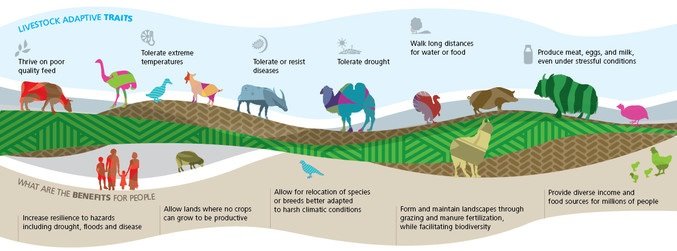
Genetic resources—both animal and plant—are the foundation of sustainable food production and global nutrition. They serve as the backbone of livestock development and agricultural resilience, playing a pivotal role in food security. With nearly 70 percent of the rural poor depending on livestock for their livelihoods, the management of these resources is essential for ensuring sustainable agricultural systems.
The Role of Animal Genetic Resources in Food Security
Animal genetic diversity contributes significantly to food security. Livestock provides essential nutrients and serves as a crucial food source for many communities. Beyond direct consumption, animals support agricultural practices through manure production, land tilling, and even pollination. The genetic diversity within livestock species enhances resilience against diseases and climate change, ensuring long-term agricultural sustainability.
The Global Plan of Action for Animal Genetic Resources
The Global Plan of Action for Animal Genetic Resources provides a strategic framework for managing livestock diversity. It focuses on four key areas:
- Characterization, Inventory, and Monitoring: Understanding the genetic diversity of livestock breeds and their unique traits.
- Sustainable Use: Ensuring that animal genetic resources are utilized in a way that enhances productivity while maintaining genetic diversity.
- Conservation: Preventing the loss of valuable genetic traits by preserving diverse breeds for future generations.
- Policies and Capacity Building: Strengthening institutional frameworks and policies to support effective genetic resource management.
National Responsibilities in Genetic Resource Management
National governments play a central role in implementing the Global Plan of Action. They must address technical and policy issues related to genetic resource management by integrating animal genetics into broader socio-economic and natural resource strategies. This approach ensures the protection and sustainable use of genetic diversity while fostering rural development.
Threats to Plant Genetic Resources
Plant genetic resources face significant threats due to agricultural homogenization. Although around 6,000 plant species have been cultivated for food, 60 percent of global crop production relies on just nine crops. This reliance on a limited number of species heightens the risk to food security. According to the Food and Agriculture Organization (FAO), plant diversity is particularly at risk in regions such as southern Africa and the Caribbean.
In-Situ and Ex-Situ Conservation Strategies
To protect plant genetic diversity, two major conservation strategies are employed:
- In-Situ Conservation: Preserving plant species in their natural habitats. However, approximately 42 percent of surveyed plant species are currently threatened.
- Ex-Situ Conservation: Storing genetic material in controlled environments such as seed banks. While effective, this approach faces significant challenges, as many countries lack the necessary infrastructure and support to maintain these repositories effectively.
Climate Change and Agricultural Diversity
Climate change poses a severe threat to agricultural biodiversity. Erratic weather patterns disrupt crop yields and reduce genetic diversity. Many nations struggle to assess and mitigate these impacts due to limited resources and unreliable seed supplies. The lack of access to diverse seeds and planting materials, especially in the wake of natural disasters, further exacerbates the problem.
Case Study: India’s Seed Hubs Initiative
Recognizing the importance of genetic diversity, India’s Ministry of Agriculture launched a seed hub initiative to enhance pulse production. By developing high-yielding seed varieties and improving distribution networks, pulse production increased dramatically from 14.76 million tonnes to 24.42 million tonnes over a decade. This initiative highlights the power of strategic planning in bolstering agricultural resilience.
A Path Forward: Strengthening Management Practices
The effective management of both animal and plant genetic resources is vital for the future of sustainable agriculture. Collaboration among governments, institutions, and local communities is necessary to safeguard genetic diversity, enhance food security, and build resilience against environmental changes. Investing in conservation strategies, policy development, and scientific research will ensure that future generations continue to benefit from the rich diversity of our planet’s genetic resources.

